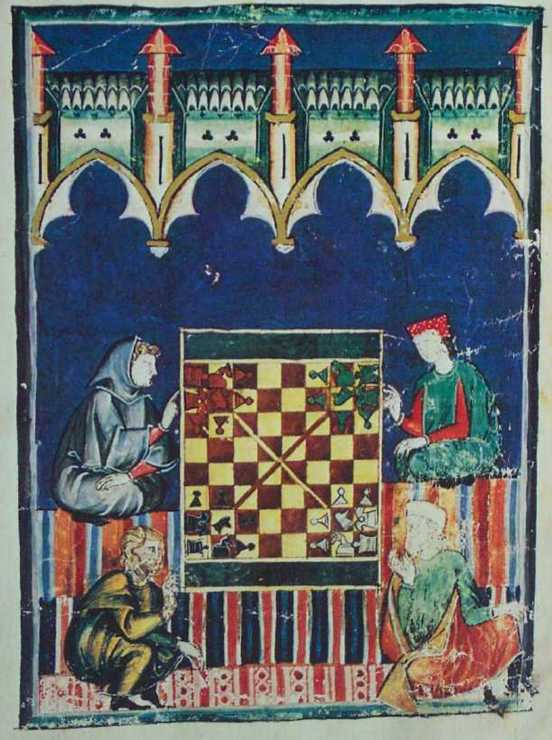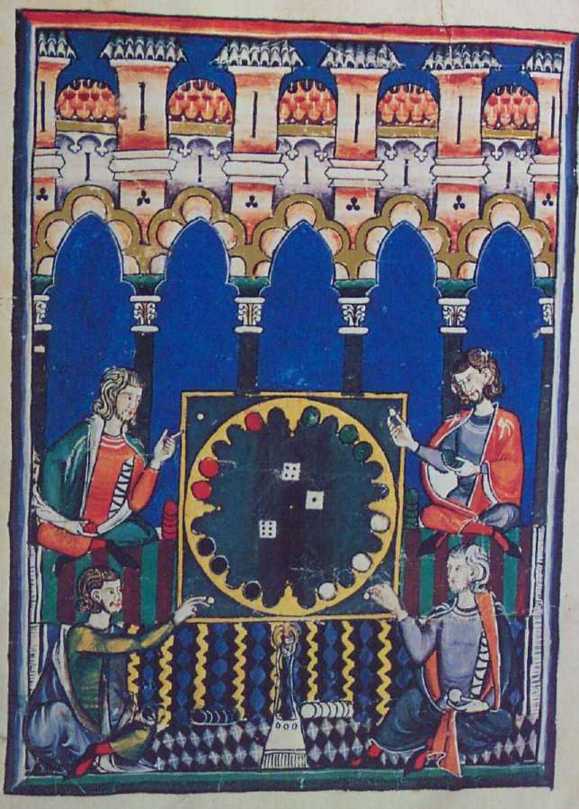Huck
http://books.google.co.uk/books?id=QnEEAAAAQAAJ&pg=RA1-PA112&dq=chartaceus+ludus#PRA1-PA110,M1
The Annual Register, Or, A View of the History, Politics, and Literature for the year 1786
(1788, London) Edmund Burke, Benjamin Franklin Collection (Library of Congress), John Davis Batchelder Collection (Library of Congress)
"Anstis" seems to be John Anstis (1669 - 1744)
http://en.wikipedia.org/wiki/John_Anstis
Edward I became 1272 King of England:
http://en.wikipedia.org/wiki/Edward_I_of_England
To this was said:
http://www.bartleby.com/81/17146.html
Not naturally a correct interpretation, especially when I think of these unknown card references of ca. 1340 in Bohemia:
http://trionfi.com/0/p/95/
(with thanks to kwaw, who refered to this article in another thread)
##########
Added:
4-King's chess in the book of Alfons the Wise (late 13th century)
... but the game is called "chess of the four seasons":

at:
http://games.rengeekcentral.com/tc4.html
The Annual Register, Or, A View of the History, Politics, and Literature for the year 1786
(1788, London) Edmund Burke, Benjamin Franklin Collection (Library of Congress), John Davis Batchelder Collection (Library of Congress)
The earliest mention of cards that I have yet stumbled upon, is in Mr. Anstis's History of the Garter (vol. II. p. 307), where he cites the following passage from the Wardrobe Rolls, in the sixth year of Edward the First. "Waltero Sturton ad opus régis ad ludendum ad quatuor reges VIII s. vd.", from which entry Mr. Anstis with fome probability conjectures, that playing-cards were not unknown at the latter end of the thirteenth century; and perhaps what I shall add may carry with it some small confirmation of what he thus supposes. Edward the First (when prince of Wales) served nearly five years in Syria, and therefore, whilst military operations were suspended, must naturally have wished some sedentary amusements. Now the Asiatics scarcely ever change their customs; and, as they play at cards (though in many respects different from ours) it is not improbable that Edward might have been taught the game, "ad quatuor reges", whilst he continued so long in this part of the globe.
"Anstis" seems to be John Anstis (1669 - 1744)
http://en.wikipedia.org/wiki/John_Anstis
Edward I became 1272 King of England:
http://en.wikipedia.org/wiki/Edward_I_of_England
To this was said:
http://www.bartleby.com/81/17146.html
E. Cobham Brewer 1810–1897. Dictionary of Phrase and Fable. 1898.
Vierge (2 syl.).
A curious conversion in playing-cards occurs in reference to this word. The invention is Indian, and the game is called “The Four Rajahs.” The pieces are the king, his general or fierche, the elephant or phil, the horsemen, the camel or ruch, and the infantry. The French corrupted fierche (general) into “vierge,” and then converted “virgin” into dame. Similarly they corrupted phil into “fol” or “fou” (knave); ruch is our “rook.” At one time playingcards were called “the Books of the Four Kings,” and chess “the Game of the Four Kings.” It was for chess, and not cards, that Walter Sturton, in 1278, was paid 8s. 5d., according to the wardrobe rolls of Edward I., “ad opus regis ad ludendum adquatuor reges.” Malkin said it was no great proof of our wisdom that we delighted in cards, seeing they were “invented for a fool.” Malkin referred to the vulgar tradition that cards were invented for the amusement of Charles VI., the idiot king of France; but it was no proof that Jacquemin Gringonneur invented cards because “he painted and gilded three packs for the king in 1392.”
Not naturally a correct interpretation, especially when I think of these unknown card references of ca. 1340 in Bohemia:
http://trionfi.com/0/p/95/
(with thanks to kwaw, who refered to this article in another thread)
##########
Added:
4-King's chess in the book of Alfons the Wise (late 13th century)
... but the game is called "chess of the four seasons":

at:
http://games.rengeekcentral.com/tc4.html


